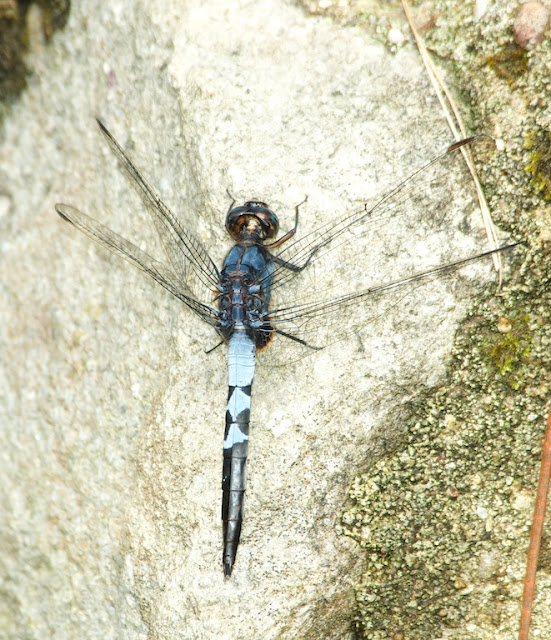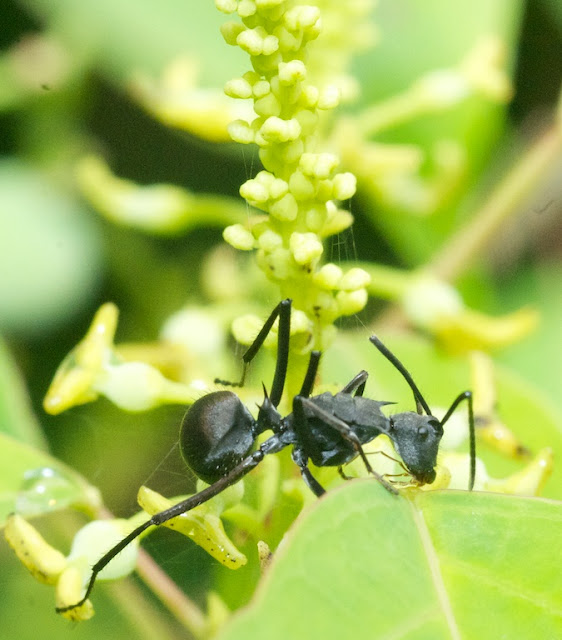We spent the morning checking out the roadside birds, from the overlook down to the upper part of the road to the lowlands. As often happens, the birds themselves did not give me much of an opportunity for closeup photography (however useful they might have been as training subjects for our guides). Here an Asian Brown Flycatcher (Muscicapa dauurica) keeps an eye on us from a safe distance. It is the dullest (and most common) of the migrant flycatchers that visit Borneo (there is also a resident race, umbrosa, in the northeast of the island).
I have always been much enamoured of forktails, the wonderful little riverside chats that decorate rocky streams through much of southern and Eastern Asia. Forktails can be absurdly tame, but the Chestnut-naped Forktail (Enicurus ruficapillus) never read that part of the field guide. It is, according to online ornithologist GrrlScientist, "notable for its extreme shyness", and is a very difficult bird to get close to (which is my way of apologizing for the quality of these pictures).
The female has a much more extensive chestnut nape patch than the male. However, the male can erect his patch into a sort of mane, as this male is doing - perhaps as a sign of nervousness at my presence?
The forktail turned up along the edge of the road, and when I could tear myself away from it I was met with a spectacular view of the hillside forest below.
This is highland dipterocarp forest, at least in part, and the dipterocarp trees were indulging in one of their occasional fruiting seasons.
The crowns of the fruiting dipterocarps, studded with pinkish fruits, stood out magnificently against the surrounding canopy.
Other plants, nameless to me, were fruiting along with the dipterocarps.
Flowering plants were not the only objects of botanical interest and beauty; consider this fallen log, draped with mosses and epiphytic, bladelike ferns.
This Bamboo Orchid (Arundina graminifolia) has caught the attention of an assassin bug (Reduviidae).
When time permitted away from my course duties, I continued my pursuit of the local damselflies. Males of Heliocypha biseriata, with their brilliant violet epaulets, vied for control of bare rocks in the local streambeds.
By the little rivulet in front of the lodge I found Coeliccia flavostriata, one of the tinier and daintier of our local damselflies. 'Flavostriata' means 'streaked with yellow', an appropriate name for this little insect.
Blue male dragonflies in the genus Orthetrum always give me identification problems. Part of this (if I may speak in my own defense) is a lack of identification materials. There are two or three such species in Borneo: glaucum, luzonicum (?) and borneense, the last an endemic, highland 'rarity' that may turn out to be less rare, and more widespread, than originally thought. Unfortunately I can find nothing really helpful that tells me how to distinguish borneense from the other two. So which is this very peculiar insect, which seems to be missing a good deal of its usual blue pruinosity? I haven't a clue (though it may well be just an odd-looking glaucum, the common species).
And what is this? I originally put it down as Orthetrum luzonicum because of its pale blue thorax, but that species has a whitish face and bright blue-green eyes, making this probably glaucum again. Also, luzonicum is supposed to have a slimmer abdomen. Besides, according to this site luzonicum doesn't even occur in Borneo. So there.
As for Orthetrum pruinosum, in Borneo you can't mistake this beautiful insect for anything else - but it seems that it is actually a complex of two very similar species, the other if which ranges from the north of peninsular Malaysia to Japan.
Trithemis festiva presents no such identification problems - it's only common relative, T. aurora, is bright pink.
For once I had brought my macro lens with me, and I deployed it to portray this Footman Moth (Areas galactina), a day-flying moth (as are many of the other members of its family, the Arctiidae). Like many day-flying moths it is as colourful as any butterfly, if not more so. Its hindwings, which you cannot see here, are a rich, buttery orange-yellow, marked with black. This is a wide-ranging insect, found from China and the western Himalayas south to Indonesia.
Not colourful, but no less spectacular in its own way, was this Black Spiny Ant (Polyrhachis armata, or one of its near relations).
The insect of the day, though, was this Giant Palm Weevil (Macrochirus sp., probably M. praetor). It had blundered into the lodge, and by the time I found it it was pretty much at death's door. Most of the world's 60,000-odd weevils are little creatures, but this one was a monster - at least the size of my thumb, not counting its massive legs and snout. It is one of the largest weevils in the world, and could serve as a perfect model for a movie alien. In fact, recalling the Mondoshawan from The Fifth Element, it seems that it has already done so.
Borneo Highlands, as I have often said before in this space, is an excellent place for butterflies. This time I only had a chance to photograph a couple of its regular species, including a Common Grass Yellow (Eurema hecabe)...
...and this Common Three-Ring (Yphthima pandocus).
This is the Bornean form of the Striped Black Crow (Euploea eyndhovii strix) - or, given the number of butterflies and moths that mimic these things, I think that is what it is.
Unfortunately this gentleman seemed to have his own ideas about butterfly appreciation at Borneo Highlands. He and his colleague were sweeping the overlook area with nets, something that isn't supposed to happen there. I suspected that, after decades of working on wildlife trade issues, I was finally having a field encounter with my first batch of wildlife poachers. I asked them as nonchalantly as possible what they were doing, and was informed, in a surly tone, that they were collecting specimens for a Japanese museum. Which one, I asked in a considerably friendlier tone, but I didn't get much of a response. The collectors quickly moved off into the forest. I reported the whole thing to Sarawak Forestry, who told me that no one had been issued collecting permits for butterflies at Borneo Highlands. I won't say more in case the gentleman in the picture (or his lawyer) is reading this, but will refer those interested to my old pal Jessica Speart's excellent book Winged Obsession (on butterfly poachers and their prey) instead.









































No comments:
Post a Comment